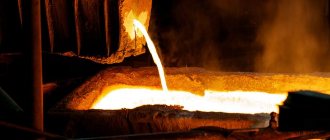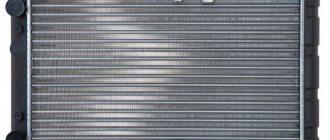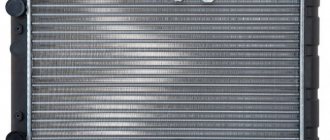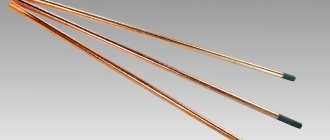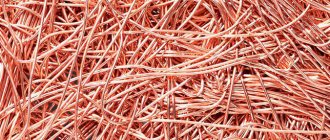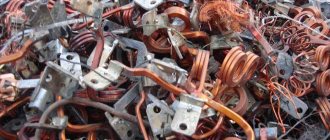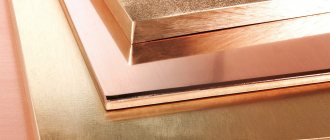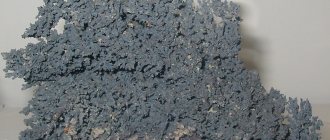Cable weight is the most important characteristic of a power line, taken into account when carrying out electrical installation work. Expressed in kilograms per kilometer of conductor, it depends on the material from which the conductors are made, their number, and cross-sectional area. Also, this calculation sometimes takes into account such characteristics of cable products as the thickness and material of the insulating layer of its conductive cores and outer sheath.
Cable calculator for calculating weight and length
Table of copper weight in ball screw wire
Copper content in ball screw wires
On a note . To calculate the weight of a cable without the help of an online calculator, use the following simple formula: Vk=πr2ρln, where r is the radius of the core, n is the number of cores, l is the length of the conductor, ρ is the density of the core material (for copper it is 8.9 g/cm3 , for aluminum –2.7 g/cm3).
Types of aluminum cable
To remove aluminum from a cable, use:
- waste that was generated as a result of repairs;
- used but removed wires.
Secondary cables:
- Flexible mounting.
- Tests. Example: for signaling. Composition: aluminum or a mixture of aluminum and copper.
- Telephone.
- Winding.
Aluminum is a valuable metal. It is used in industrial activities due to the following characteristics:
- strength;
- ease;
- high electrical conductivity.
Please note: the properties of aluminum are preserved only with proper quality. Therefore, before accepting scrap, it is checked for its aging condition. In addition to aluminum, collection points are interested in copper. Which cables contain copper is described in another article.
Cable marking when selling for scrap:
- Cable Al-lx_2a. This group includes any cable based on aluminum with a core thickness of at least 5 mm. It should not be dirty or contain foreign metals. Can be taken naturally. Traces of exposure to elevated temperatures and blackening of the wire are allowed.
- Al_Al1 or "Electrotech". A cable that lacks insulation. It has no additional elements. The price of this model is approximately twice as high as that of a simple insulated cable.
- Mixture. If there is some aluminum in the wire, but it does not meet the first two categories, it is accepted at a low cost.
Typically, the inner conductive layer consists of several compartments, each of which has its own insulation and resin-impregnated paper.
In some cases, you can detect booking components:
- wires;
- steel tapes.
Additional elements may include:
- paper bundles;
- polymer films;
- bitumen pillows.
The outer part of the cable can be covered with:
- fiberglass;
- PVC composition;
- yarn.
These components will need to be cleaned when the cable is handed over to a metal collection point. But companies that collect used cables independently carry out a similar procedure, and quite successfully.
Cable voltage loss calculator
When designing power lines of long length, the choice of conductor according to the cross-section and material of the current-carrying cores is made not only on the basis of the power of the connected load, but also taking into account the voltage loss (∆U).
Formulas for calculating the voltage drop in a cable line
Example No. 1 Calculation of line voltage loss (between phases)
Initial data
A line 100 meters long is connected to a three-phase source (nominal voltage - 380 V, current - 16 A, shift angle - 180) of electric current using a power conductor of the VVGng brand 4x6 mm sq. with inductive and active resistances of 0.09 and 3.09 Ohm/km, respectively.
Calculation
According to the formula shown in the picture, the voltage drop will be equal to:
∆U = √3•I• (R•Сosȹ•L+X •Sinȹ•L) = 1.73•16•(3.09•0.95•0.1+0.09•(-0.75 ) •0.1)=27.68•0.287=7.93 V.
Thus, in this case, a voltage loss of 7.93 V or 2.09% of the nominal value is observed in the laid section.
Example No. 2 Calculation of phase voltage losses (between phase and zero)
Initial data
A line 50 meters long is connected to a single-phase power source (rated voltage - 220 V, current - 5 A, shift angle - 180) of electric current using a power conductor brand VVGng-LS 3x4mm sq., the inductive and active resistance of which is 0.095 and 4.65 Ohm/km, respectively.
Calculation
According to the formula shown in the picture, the voltage drop will be equal to:
∆U = 2•I• (R•Сosȹ•L+X •Sinȹ•L) = 2•5•(4.65•0.95•0.05+0.095•(-0.75) •0.05 )=10•0.216= 2.16 V.
Thus, in this case, a voltage loss of 2.16 V or 0.98% of the nominal value is observed in the laid section.
Important! According to GOST R 50571.5.52-2011, the maximum permissible voltage drop on lighting devices powered from the general power supply system should not exceed 3% of the rated value. For other devices, it is allowed to reduce the supply voltage relative to the nominal by 5%. If these standard values are exceeded, devices and equipment connected to the network may not operate correctly (their power and performance are reduced, spontaneous shutdown is observed). In some cases, if electrical appliances have controllers that are very sensitive to mains voltage, the latter may fail, thereby rendering the heating gas boilers, refrigerators, and pumping stations they control unusable.
How to clean the cable from unnecessary elements?
The wire gets rid of unnecessary elements, and only aluminum remains. There are several ways to do this.
There is a machine and manual option. Metal receiving company employees usually use the manual option, since the material does not lose quality, and the weight of aluminum is maintained at the proper level, starting from 13 kg per kilometer.
Please note: the manual version is perfect if the wire length does not exceed one meter.
Cleaning method: the cable is cut to its diameter and the surface is removed. If it is multi-core, it is necessary to cut carefully so as not to damage the integrity of the internal elements. As a rule, when making a cut, you can easily clear the wire of unnecessary material.
It is advisable to use special scissors or a multitool. The speed of the process using a special tool increases significantly.
The machine version is used when there are a large number of wires at the receiving point. For this purpose, a machine with vibration and electromagnetic methods is used.
It performs tasks such as:
- sorting;
- granulation;
- separation;
- splitting up;
- disposal.
Before processing on the machine, the operator separates the cable:
- to size;
- by the presence of other valuable metals (copper, steel and others).
Cables containing resin are processed separately. They need more careful processing. Our company is engaged in proper cleaning, without reducing the cost of the final product.
Do you want to sell your cable at a competitive price? Contact our company at the address indicated on the website or contact our managers by phone.
Calculator for calculating cable cross-section by power and current
The algorithm for selecting the wiring cross-section based on load power includes the following steps:
- of the total power ( Ptotal ) of all electrical appliances connected using a conductor ( P1 - Pn) using the formula below :
Ptotal= P1+ P2+ P3+ Pn.
At the same time, for consumers such as electric motors and transformers, the reactive power given in the passport is converted into active power according to the following formula:
P = Q / cosφ.
- Search for values of simultaneity coefficients (K) and margin (J). In practical calculations, the K value is used equal to 0.8-0.85, J – 2.0.
- Calculation of the total active power ( P a ) taking into account correction factors K and J using the following formula:
Pa = Ptot• K• J.
- Select a conductor with the optimal cross-sectional area using the reference table (Fig. below).
Example No. 1
It is necessary to connect a group of electrical appliances with a total power of 5000 W to the three-phase input panel using a separate cable line laid in the wall.
On a note. The power of any electrical appliance can be found in its technical data sheet, instruction manual or on a special plate attached to its body.
The total active power of this group of devices, taking into account the simultaneity and reserve factors, will be equal to:
Pa = Ptot• K• J = 5000 • 0.8•2= 8,000 W or 8.0 kW.
For this power value, a copper conductor with a core cross-section of 2.5 mm square will be optimal.
Calculating the cross-section of a line based on the current supplied to it through a cable calculator has a procedure similar to the previous one:
- For each consumer, the current consumption is calculated using the formula I=P/U;
- The current values calculated for each device are summed up and multiplied by coefficients K and J;
- Using the reference table (Fig. below), a conductor is selected that has a cross-section capable of passing the design current.
Selecting the conductor cross-section based on the power and current of electrical appliances connected with it
Example No. 2
The total current strength of devices connected to a single-phase network is 15 A. Taking into account the coefficients K and J, it will be equal to 18 A. For laying such closed wiring and connecting devices with this total current value, a copper wire with a cross-section of 4.1 mm square is suitable.
History of cable development
Copper is one of the oldest known metals. Its plasticity and electrical conductivity were exploited by the first electrical experimenters, Benjamin Franklin and Michael Faraday. It was used in inventions such as the telegraph, telephone and electric motor.
Copper is the most common metal conductor. The International Annealed Copper Standard (IACS) was adopted in 1913. According to this global standard, commercially pure annealed copper has a conductivity of 100% IACS. However, such copper produced today has higher IACS conductivity values because processing technology has improved significantly since then. Today, annealed copper wire used in electrical circuits meets international ASTM B3 standards.
In the 1960s and 1970s, due to the high price of copper, aluminum power cables began to be used to connect industrial and residential electrical networks. Aluminum conductors are made up of different alloys known as AA-1350 series and AA-8000 series. The AA-1350 series contains a minimum of 99.5% aluminum. The AA-8000 Series aluminum alloys meet the international standard ASTM B800 and have been developed to give aluminum creep and elongation properties closer to those of copper.
GOST cable
The choice of brand of cable products by cross-section, material, and installation method is regulated by such regulatory documents as:
- GOST R 50571.5.52-2011;
- GOST 31947-2012;
- GOST 10348-80;
- GOST 7399-97;
- PEU-7.
The requirements of these documents need to be known not only to specialists involved in electrical installation work, but also to simple home craftsmen who independently install wiring in their houses and apartments.
How to choose the right cable for PEU
In the USSR, most of the housing stock was equipped with aluminum power cables; this was the norm, the current standard. This did not mean at all that the country was poor and could not afford to massively use copper in electrical engineering, rather the opposite. It’s just that electrical network designers decided that it was economically advantageous to use aluminum rather than copper.
It must be admitted that at that time the pace of construction was so enormous that the electrical industry was provided with orders for five years in advance. During this period, the well-known Khrushchev buildings were built, in which a significant part of Russians still live. Therefore, the economic effect from such a massive use of aluminum cable products was indeed significant. Today the realities are completely different, and aluminum power cables are not used in new residential buildings, but only copper cable products, which corresponds to clause 7.1.34 of the PUE.
For aluminum power cable, the above section of the PUE left another area of application. Thus, it is preferable for lines supplying distribution networks to be made with aluminum current cores, in projects where their design cross-section will be 16 mm2 or higher. In addition, a large area of current receivers, which relates to the maintenance of electrical equipment of objects: pumping, fan and heater electrical installations can power cables with aluminum current cores with a cross-section of more than 2.5 mm2.
To summarize the above, we can confidently say that the existing standards clearly separate the areas of application of aluminum and copper power cables, taking into account all their technical and cost characteristics. However, today designers, architects, and electrical engineers working on electrical power supply projects must overcome the bias towards the use of aluminum products, especially since this technology has made great strides in the quality of this metal. This approach will make it possible to use economical aluminum during installation, which will provide significant savings throughout the country.
Cable channel
Cable channels are electrical installation boxes used for laying lines of different voltage levels and purposes (from high-voltage power lines to cable communication channels). Depending on the material of manufacture, they can be metal or plastic.
The boxes are laid both on horizontal (floor, ceiling) and vertical (walls) surfaces. To protect the wiring placed in them from environmental influences, the channels are covered with special covers.
Material for manufacturing current-carrying conductors
Of course, the basis for the price of cable scrap is the type of metal used. The conductors of the main line can be made of the following materials:
copper;
aluminum;
steel.
In exclusive cases, the cores can be made of precious metals; of course, in this case there is no need to talk about cable scrap, because Such cables will have a limited number and small sizes:
silver;
gold.
The first two metal options are the most common for most types of cable. Also, alloys or bimetallic materials are often used as a current-carrying conductor.
An important factor when dismantling cable scrap: cleaning the conductive part from insulation and sheathing is the cross-sectional diameter of the core and their number. In particular, a single-core power copper cable with a cross-section of more than 75 square meters. mm. It’s easy to clean it yourself without damaging the integrity of the metal component.
Cable diameter
This characteristic of cable products is measured by the outer sheath. The value of the diameter is influenced by such design features of the conductor as the thickness of the outer insulation, the number and cross-sectional area of the conductors. The outer diameter varies from 5-5.5 to 80-100 mm.
Thus, using both an online cable calculator and calculation of its weight and cross-section using the above methods, you can independently calculate the number and select the brand of wires (VVG, AVVG VBBShV, PVS, etc.) required to connect a cottage or country house home to the nearest power line.
Aluminum or copper cable: what's the difference?
Only two metals - copper and aluminum - have become widespread for transmitting electricity. Their use in this capacity is explained by a set of physical parameters and cost. In modern power supply systems, copper is mainly used to connect residential, public and industrial facilities. Exceptions are when connecting a powerful load requires a large cross-section of the core - in this case, an aluminum power cable is used. It is difficult to immediately say unequivocally which is better for use with an aluminum or copper cable; you need to compare all the characteristics together:
- Price advantages;
- Physical properties;
- Operating and safety conditions.
Price advantages
Aluminum is almost three times cheaper than copper. This makes it more desirable for use, especially in high-power, long-distance projects. The copper costs in these options can significantly increase the cost of an electrical project.
A comparative analysis of price trends for these two metals over the past hundred years clearly demonstrates that aluminum prices are growing much lower than copper prices. Experts believe that this trend will continue in the near future. Since the beginning of 2021, the price of copper on the London Stock Exchange has reached $5,675/t, while for aluminum it has reached $1,725/t. The above is associated with production efficiency and increased aluminum production, with accessible and cheap raw materials. In the production of cables, aluminum in the price of the final product reaches 25%.
For copper the situation is the opposite. Copper ore reserves are declining, the percentage of copper in ore is decreasing, and new deposits are also poor in pure copper and are becoming difficult to access. For this reason, copper costs in the price of the final product already account for more than 50% and continue to grow. All of the above speaks in favor of using aluminum.
Weight characteristics
Aluminum is a lightweight material and very flexible, making it easy to work with. This characteristic is useful for quick installation, and with long spans of power lines, wire aluminum modifications are installed much faster. As a raw material, aluminum is approximately 70 percent lighter in weight than copper. This is useful in areas where weight reduction of all electrical network components is required.
Naturally, when used in electrical cables, the lighter weight makes them easier to install. Therefore, high-voltage lines have long been laid from aluminum. Low weight significantly reduces the tensile force applied to the cable and mast. For power supply applications requiring flexible cabling, copper is no longer the preferred choice.
Cable conductivity and tensile strength
The conductivity of aluminum compared to copper is only 61%, which leads to the fact that when using aluminum cable, larger diameter conductors are required, which naturally increases the weight of the line.
Copper is not subject to high cyclic expansion/contraction compared to aluminum. Copper's tensile strength allows it to withstand wear stress for long periods of time without the damaging effects of aluminum.
Due to its high plastic properties, copper can be produced in the form of a very thin wire. This adds versatility to copper power cable. Copper has high tensile strength and can be subjected to extreme stress while showing minimal signs of wear, so this power cable requires virtually no maintenance.
Cable safety
Melting a copper core requires a high temperature of 1083 C. Therefore, from a safety point of view, a copper power cable is one of the safest options for organizing power supply to facilities. Even if it is overloaded, it is unlikely to melt or burn. This means that the chances of a fire occurring if there is a power problem will be significantly less.
Aluminum power cable increases the potential risk of fire at the facility, especially if it is not installed in accordance with the PUE. The expansion and contraction cycles inherent in aluminum have a major impact on the safety of connections compared to copper.
Aluminum is also susceptible to oxidation, especially when it is in contact with moisture and dissimilar metals. In the damaged area, strong wire resistance occurs, which leads to heat that can melt the protective insulation and cause a fire.
To prevent these negative phenomena, anti-oxidation compounds are used in aluminum power cables. These lines require a higher level of maintenance than copper power cables, which includes checking the conductors for leaks and oxidation.
Finally, the increased thermal fluidity of aluminum is something that must be taken into account during installation. Aluminum is a softer metal than copper and tends to expand or stretch over time, especially when exposed to higher pressure and temperature. Classic crimp connections that suffer from leakage lose their strength and are no longer reliable.
